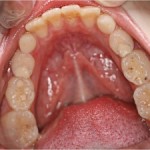
We recently reported on a other fluoride varnish study in a similar age group conducted in the UK. The aim of this study was to determine the efficacy of 5% sodium fluoride (NaF) varnish application in reducing caries increments in the permanent dentition of rural Brazilian school children over the course of 12 months.
Children aged 7–14 years who attended three schools in Brazil were randomised to either a treatment (5% NaF varnish, n = 198) or a control group (placebo, n = 181). The schools were visited four times at 6-month interval for recruitment, dental examinations, and fluoride varnish applications. Trained interviewers collected data on oral health habits and sociodemographic characteristics from the children with diet information being collected using a 7-day food frequency diary. Caries examinations were conducted using the International Caries Detection and Assessment System (ICDAS). The efficacy of fluoride varnish application on caries prevention was reported as a preventive fraction (PF).
They found that
Of the total sample (N = 379), 210 (55.4%) children had completed 12 months of follow-up including one or two applications of fluoride varnish or placebo. After 12 months of follow-up, the children in the varnish group showed significantly lower DFS increments than did children in the control group. This represents a preventive fraction of 40% (95% CI: 34.3–45.7%;P < 0.0001).
[table id=14 /]
The authors concluded
The results of this study suggest that applications of 5% NaF varnish can be recommended as a public health measure for reducing caries incidence in this high-caries-risk population.
Arruda AO, Senthamarai Kannan R, Inglehart MR, Rezende CT, Sohn W. Effect of 5% fluoride varnish application on caries among school children in rural Brazil: a randomized controlled trial. Community Dent Oral Epidemiol. 2011 Dec 8. doi:10.1111/j.1600-0528.2011.00656.x. [Epub ahead of print] PubMed PMID: 22150341.
Related review
Marinho VCC, Higgins JPT, Logan S, Sheiham A. Fluoride varnishes for preventing dental caries in children and adolescents. Cochrane Database of Systematic Reviews 2002, Issue 1. Art. No.: CD002279. DOI: 10.1002/14651858.CD002279.

Please point me to the studies which show that fluoride varnish does not have any adverse side effects. Since the varnish contains up to 26,600 parts per million fluoride, some children will react badly to it. What are the symptoms to look for?
The commonest side effect from topical fluoide use is dental fluorosis. The recent Cochrane review by Wong et al did not identify any fluoride varnish studies. Fluoride varnishes may contain colophony to which some people are hypersensitive so use in these patients is contrindicated. One case of colophony associated allergic contact stomatitis in an adult male was reported in 2006 by Sharma. A 2004 review by Seppa noted ” No acute toxocity has been reported after using any fluoride varnish”